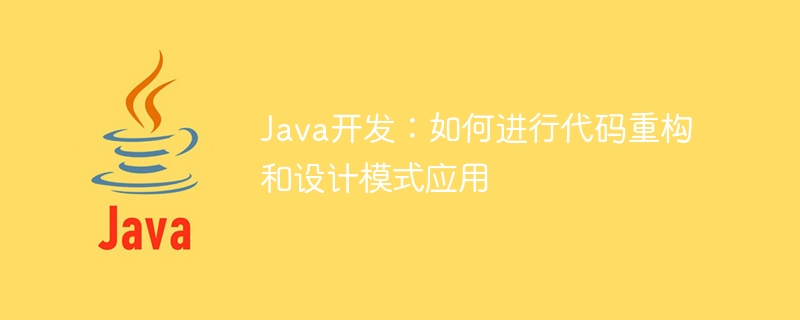

Java development: How to perform code refactoring and application of design patterns
In software development, code refactoring and application of design patterns are important to improve code quality and maintainability important means of sex. Code refactoring refers to improving the structure, design, and performance of existing code, while design patterns are proven templates for solving problems. This article will introduce how to refactor code and apply design patterns, and give specific code examples.
1. Code Refactoring
The extraction method is to extract a repeated piece of code into an independent method. Used to increase code readability and maintainability. For example, the following code has repeated logic in multiple places:
public void printUserInfo(User user) { System.out.println("Name: " + user.getName()); System.out.println("Age: " + user.getAge()); System.out.println("Email: " + user.getEmail()); } public void printOrderInfo(Order order) { System.out.println("Order ID: " + order.getId()); System.out.println("Order Date: " + order.getDate()); System.out.println("Order Total: " + order.getTotal()); }
We can extract this repeated code into an independent method:
public void printInfo(String label, Printable printable) { System.out.println(label + printable.getInfo()); } public interface Printable { String getInfo(); } public class User implements Printable { // ... public String getInfo() { return "Name: " + name + " Age: " + age + " Email: " + email; } } public class Order implements Printable { // ... public String getInfo() { return "Order ID: " + id + " Order Date: " + date + " Order Total: " + total; } }
By extracting the method, we can Reduce code duplication and better encapsulate and reuse logic.
When we find that there is repeated logic in multiple conditional expressions, we can merge them into a simpler one , more readable expressions. For example, the following code has repeated judgment logic:
public double calculateDiscount(double price, int quantity) { double discount = 0.0; if (price > 100 && quantity > 5) { discount = price * 0.1; } else if (price > 200 && quantity > 10) { discount = price * 0.2; } else if (price > 300 && quantity > 15) { discount = price * 0.3; } return discount; }
We can merge this repeated condition into a simpler expression:
public double calculateDiscount(double price, int quantity) { double discount = 0.0; if (price > 300 && quantity > 15) { discount = price * 0.3; } else if (price > 200 && quantity > 10) { discount = price * 0.2; } else if (price > 100 && quantity > 5) { discount = price * 0.1; } return discount; }
By merging the repeated conditions, we can Improve code readability and maintainability.
2. Design pattern application
The singleton mode is a method that ensures that a class has only one instance and provides Design pattern for global access points. In actual development, the singleton mode is often used to manage shared resources, configuration information, etc. The following is a simple example of the singleton pattern:
public class Singleton { private static Singleton instance; private Singleton() {} public static Singleton getInstance() { if (instance == null) { synchronized (Singleton.class) { if (instance == null) { instance = new Singleton(); } } } return instance; } }
By using the double-checked locking mechanism, we can ensure that a unique instance is created in a multi-threaded environment.
Factory pattern is a design pattern that creates different objects based on different parameters. In actual development, the factory pattern is often used to hide the creation logic of objects and provide a consistent interface to create objects. The following is a simple factory pattern example:
public interface Shape { void draw(); } public class Circle implements Shape { public void draw() { System.out.println("Drawing a circle."); } } public class Rectangle implements Shape { public void draw() { System.out.println("Drawing a rectangle."); } } public class ShapeFactory { public static Shape createShape(String type) { if (type.equals("circle")) { return new Circle(); } else if (type.equals("rectangle")) { return new Rectangle(); } return null; } }
By using the factory pattern, we can decouple the creation and use of objects, increasing the flexibility and maintainability of the code.
Summary:
Code refactoring and the application of design patterns are important means to improve code quality and maintainability. By properly refactoring code and applying design patterns, we can reduce code duplication and improve code readability and maintainability. In actual development, we also need to choose appropriate refactoring techniques and design patterns to optimize the code based on the actual situation and design requirements of the project.
The above is the detailed content of Java development: How to refactor code and apply design patterns. For more information, please follow other related articles on the PHP Chinese website!




